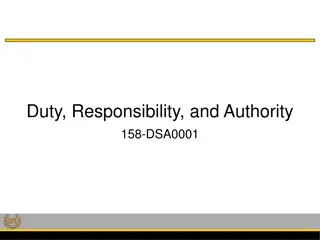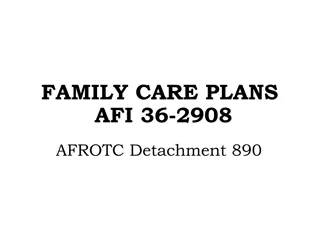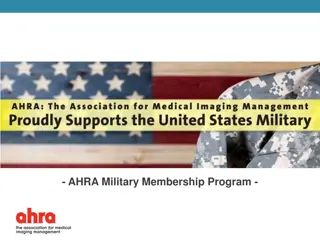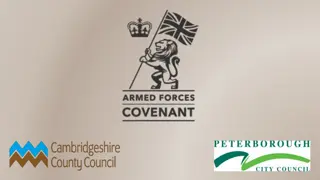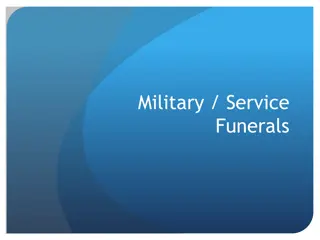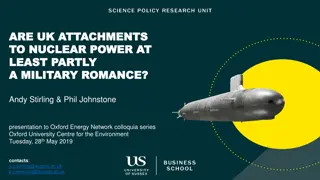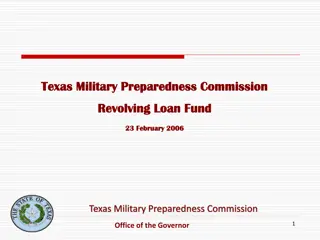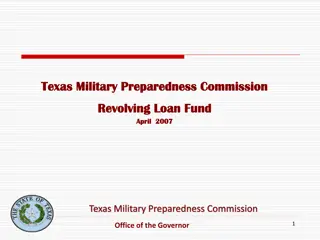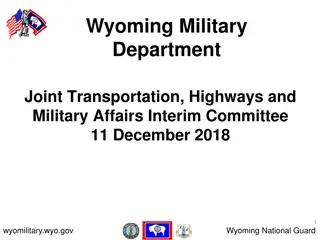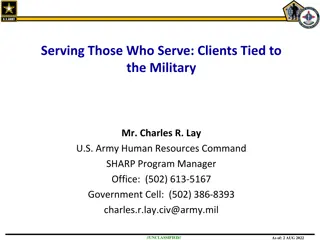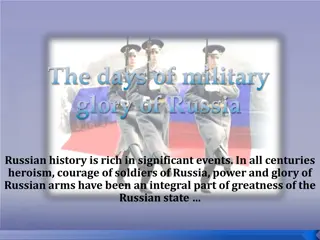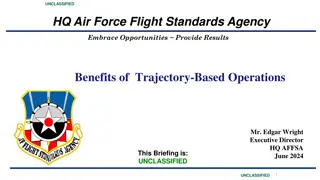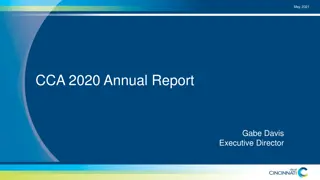Understanding Military Culture: Key Insights and Demographics
Exploring the importance of understanding military culture for better client support, treatment outcomes, and appreciation of military service. Delve into military structure, values, and demographics, including service branch sizes, gender distribution, and racial profiles.
Download Presentation

Please find below an Image/Link to download the presentation.
The content on the website is provided AS IS for your information and personal use only. It may not be sold, licensed, or shared on other websites without obtaining consent from the author.If you encounter any issues during the download, it is possible that the publisher has removed the file from their server.
You are allowed to download the files provided on this website for personal or commercial use, subject to the condition that they are used lawfully. All files are the property of their respective owners.
The content on the website is provided AS IS for your information and personal use only. It may not be sold, licensed, or shared on other websites without obtaining consent from the author.
E N D
Presentation Transcript
Understanding Military Culture Joshua Bode, LCSW Veterans Justice Outreach Coordinator, Boise VA Medical Center
Knowledge and understanding of military culture can lead to: Increased ability to relate to and support your Veteran client resulting in a stronger therapeutic alliance - the strongest determinant of treatment outcome. Deeper understanding of the context for mental health symptoms and conditions. Improved treatment planning that is informed by increased military cultural knowledge. Increased appreciation for military service.
Learning about military culture includes a deeper understanding of both the: Structure of the military such as branches and ranks. Missions, ideals and core values of military culture.
Learning Objectives Become familiar with military terms and demographics Describe stressors in the military Implications for Treatment Court Teams
Service Branch Sizes Assigned Strength of Active Duty Force Service Enlisted Army 452,064 Navy 275,296 Marine Corps 178,213 Air Force 258,095 Coast Guard 33,228 Total 1,196,897 Officers 87,610 51,388 20,202 64,805 8,134 232,139 Total 539,675 326,684 198,415 322,900 41,362 1,429,036 Percentage 37.8% 22.9% 13.9% 22.6% 2.9% 100%
Female Service Members Active Duty Gender Distribution Service Army Navy Marine Corps Air Force Coast Guard Total Enlisted Percent Female 13.2 % 15 % 6.2 % 19.9 % 11.6 % 14 % Officer Percent Female 15.5 % 15.1 % 5.8 % 18.3 14.9 % 15.3 %
Race Profile of Military Active Duty Gender Distribution Service Army Navy Marine Corps Air Force Coast Guard Total Total Race Profile of Active Duty Force Service Army Navy Marine Corps Air Force Coast Guard % White 73.9 % 66.2 % 83.7 % 78.1 % 82 % 74.6 % Enlisted Percent Female 13.2 % 15 % 6.2 % 19.9 % 11.6 % 14 % 25.4 % % Minorities 26.1 % 33.8 % 16.3 % 21.9 % 18 % Officer Percent Female 15.5 % 15.1 % 5.8 % 18.3 14.9 % 15.3 % 17.8 % % Black 21.5 % 19.3 % 11.1 % 15.6 % 6.1 % % Other 4.6 % 14.4 % 5.2 % 6.3 % 11.9 % 7.6 %
Diversity 33% of Active and 25% of Reserve Guard are racial/ethnic minorities. Representation of most of these groups are parallel or higher than general population. Asian and Hispanic representation is lower than general population
Military Branches Army = Soldier Air Force= Airman Navy= Sailor Marine Corps= Marine Coast Guard= Guardian
Military Core Values Army- Loyalty, Duty, Respect, Selfless Service, Honor, Integrity, and Personal Courage Air Force- Integrity First, Service Before Self, Excellence In All We do Coast Guard- Honor and Integrity, Greater Good of the Coast Guard, Innovation, Personal Initiative, Drive for Success, and Teamwork Marines- Honor, Courage, Commitment Navy- Honor, Courage, Commitment
Army Mission Fight and win our Nation s wars by providing prompt, sustained land dominance across the full range of military operations and spectrum of conflict in support of combatant commanders.
Air Force Mission To fly, fight, and win in air, space and cyberspace. Distinctive Capabilities 1. Air and Space Superiority 2. Global Attack 3. Rapid Global Mobility 4. Precision Engagement 5. Information Superiority 6. Agile Combat Support
Coast Guard Mission The United States Coast Guard is a multi- mission, maritime military service within the Department of Homeland Security and one of the nation s five armed services. Its core roles are to protect the public, the environment, and U.S. economic and security interests in any maritime region in which those interests may be at risk, including international waters and America s coasts, ports and inland waterways.
Navy Mission The mission of the Navy is to maintain, train and equip combat-ready Naval forces capable of winning wars, deterring aggression and maintaining freedom of the seas.
Marine Corp Mission The Marine Corps has been America's expeditionary force in readiness since 1775. We are forward deployed to respond swiftly and aggressively in times of crisis. We are soldiers of the sea, providing forces and detachments to naval ships and shore operations. We are global leaders, developing expeditionary doctrine and innovations that set the example, and leading other countries' forces and agencies in multinational military operations. These unique capabilities make us "First to Fight," and our nation's first line of defense
Military Rank Enlisted Personnel (E-1 through E-9) Warrant Officers (W-1 through W-5)- highly specialized experts (2% of military) Commissioned Officers (O-1 through O-10)
MOS/NEC/AFSC Marines, Army, and Coast Guard use MOS or Military Occupational Specialty Navy uses Navy Enlisted Classification Air Force uses Air Force Specialty Code
Military Status Active Duty Full Time Reserve/Guard Federal/State 39 days/year Typically monthly drills two-week annual training May be called to Active Duty for deployments Lack the support system Active Duty has returning from deployment.
Military Acronyms and Terms FRG = Family Readiness Group ARNG = Army National Guard FAC = Family Assistance Center TAG = The Adjutant General MOBEX = Mobilization Exercise ANG = Air National Guard TDY = Temporary Duty FOB= Forward Operations Base OIC = Officer In Charge NCO = Noncommissioned Officer NCOIC= Non-Commissioned Officer in Charge JAG = Judge Advocate General KIA = Killed In Action MRE = Meals Ready to Eat AIT= Advanced Individual Training UCMJ= Uniformed Code Military Justice SARC= Sexual Assault Response Coordinator NBC= Nuclear, Biological, Chemical Weaponry
Military Stressors Life Threat (combat/deployment) Loss Inner Conflict Wear and tear/lack of control
Military Sexual Trauma Active Duty personnel (with reference to the past year) have experienced: Offensive sexual behavior: 52% of women and 29% of men Unwanted sexual attention: 31% of women and 7% of men Sexual Coercion: 9% of women and 3% of men Unwanted sexual contact: 6.8% of women and 1.8% of men VA population (with reference to their entire military service) experienced: MST: 21.4% of women (48,106) and 1.1% of men (43,693)
MST Consequences Distress and Mental Illness Lower physical health and self esteem More severe PTSD symptoms. More severe consequences because: Interpersonal Trauma Perpetrated by someone who is presumably supposed to be protecting your life It may not be possible to report the crime, for a variety of reasons It may be coupled with combat exposure as well
Impact of Combat The level of combat is the main determinant of mental health status Deployment Length, family seperation, and number of deployments also a major factor Soldiers/Marines with mental health problems were more likely to mistreat non-combatants.
Whats Soldiers and Marines Experienced Army Marines 93% 94% 93 97 Saw dead bodies Had been shot at Know someone who was wounded or killed Saw injured or killed Americans Was responsible for enemy deaths 86 87 65 75 48 65
Rates of Mental Health Issues Self-reported PTSD: 14.1% PTSD, Depression, or anxiety: 16.7% More than half of members positive for mental health problems would not seek care. 60-90 days post deployment, mental health issues reported at following rates: Army 38% Marines 31%
Family Strain Examples are Divorce and Family Violence High marital satisfaction typically but problems have increased over years due to deployments. Families are crucial for recovery and are often the first to recognize stress problems in service members.
Substance Use No tolerance in Military for drug use Alcohol use is very acceptable and often times encouraged in some military units Prescription Drugs (narcotics particularly) have been used to keep people fighting Veterans tend to be more likely to abuse alcohol or prescription drugs due them being legal and accepted during military service
Battlemind Buddies (cohesion) vs. Withdrawal Accountability vs. Controlling Targeted Aggression vs. Inappropriate Aggression Tactical Awareness vs. Hypervigilance Lethally Armed vs. Locked and Loaded at Home Emotional Control vs. Anger/Detachment Mission Operational Security (OPSEC) vs. Secretiveness Individual Responsibility vs. Guilt Non-Defensive (combat) Driving vs. Aggressive Driving Discipline and Ordering vs. Conflict
Military Acronyms and Terms FRG = Family Readiness Group ARNG = Army National Guard FAC = Family Assistance Center TAG = The Adjutant General MOBEX = Mobilization Exercise ANG = Air National Guard TDY = Temporary Duty FOB= Forward Operations Base OIC = Officer In Charge NCO = Noncommissioned Officer NCOIC= Non-Commissioned Officer in Charge JAG = Judge Advocate General KIA = Killed In Action MRE = Meals Ready to Eat AIT= Advanced Individual Training UCMJ= Uniformed Code Military Justice SARC= Sexual Assault Response Coordinator NBC= Nuclear, Biological, Chemical Weaponry
What do we learn from this? Veterans have a history of pro-social behavior in most cases They bring along a set of values instilled in them through military training They are trained to a point in which their reaction is at times without thought. This is crucial in a combat situation Often times, the mental health issues we are dealing with are the result of trauma
How do we apply this? Veterans have not lost those core values they have been taught Understanding and emphatically addressing trauma history will reduce substance use and symptoms of PTSD Retraining is needed to allow veterans to step away from training that kept them safe in combat
How do we apply this? (cont.) Sense of purpose is a major key in recovery for these veterans Family is extremely important Listening is often times more important than understanding Veterans will strive in a situation where there are clear policies and structure



